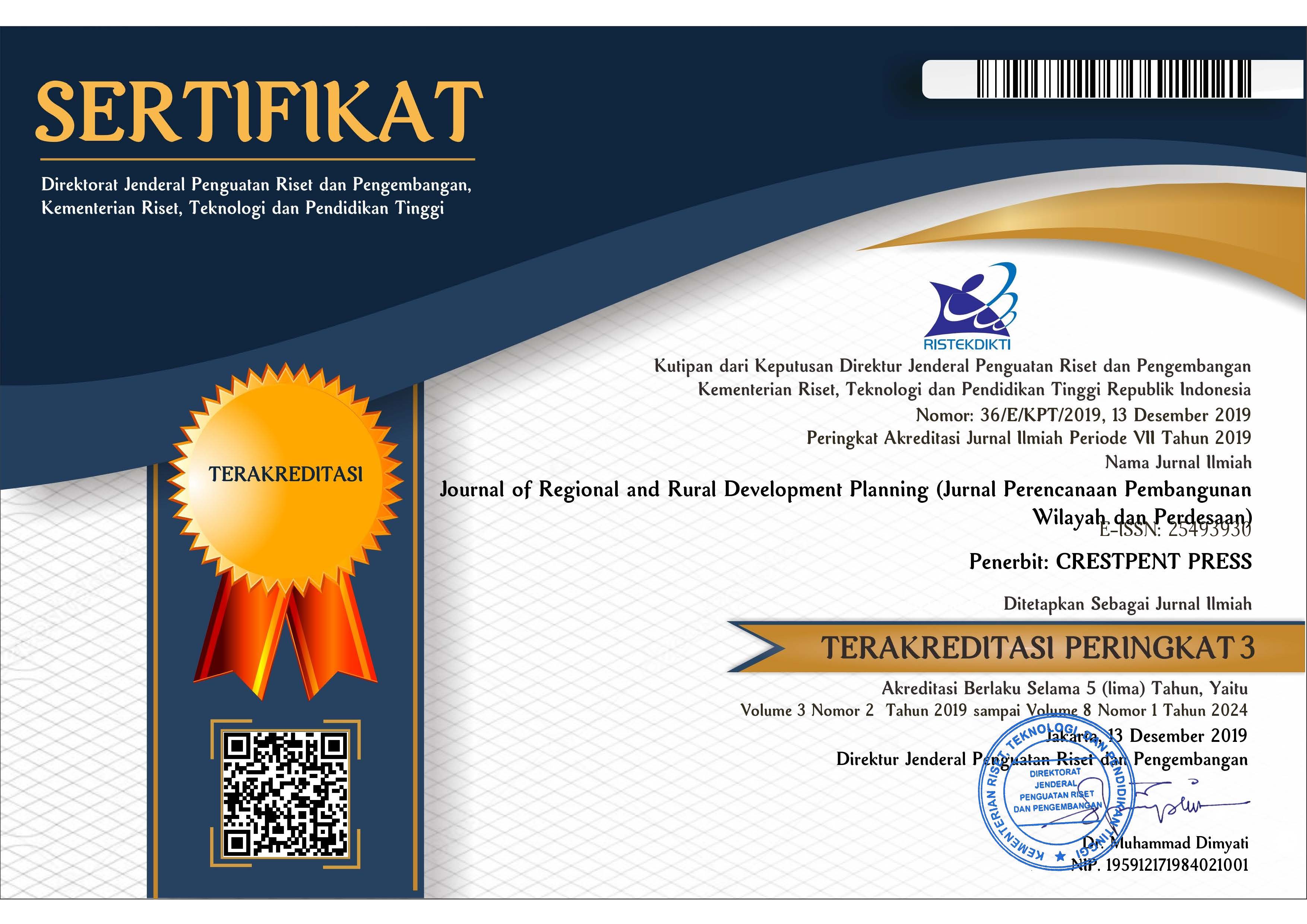Indeks Pembangunan Berkelanjutan Lokal dan Sebaran Spasialnya di Kabupaten Mandailing Natal, Provinsi Sumatera Utara
Local Sustainable Development Index and Its Spatial Distribution in Mandailing Natal Regency, North Sumatera Province
Abstract
The concept of sustainable development is very important to increase our quality of life. Measurement of development based on specific indicators is one of the approaches to describe sustainable development. At the local level, measuring sustainable development using specific indicators is still rare. Since each location has their own unique characteristics, measuring sustainability at the regional level could not always be applied locally. The availability of data at the village level strongly encourages the local measurement of sustainable development index. The economic, social, and environmental dimensions of Mandailing Natal Regency's development are still constrained. Using 21 variables that can reflect economic, social, and environmental aspects, this study aims to measure the sustainable development index at the local level. The Local Sustainable Development Index will be generated by analyzing these variables using the Factor Analysis (FA) method and Local Indicator of Spatial Autocorrelation (LISA) analysis. This index measurement is useful in considering the direction of location-based (spatial) development for decision makers at the local level and describe development sustainability. In general, IPBL economic value was in the medium category in 2011, and several villages in the low category were able to enhance their economic development sustainability in 2018. In the northwest, IPBL environment cluster type High-high (HH). In 2018, the percentage spatial distribution pattern of villages with the Low-low (LL) cluster type of IPBL economic and IPBL environment decreased. However, as can be seen from the spatial distribution pattern of IPBL social with cluster type LL, the percentage increased in 2018.
References
Arlinghaus, S. L. (1996). Practical Handbook of Spatial Statistics. CRC Press Inc
Atifah, Y. & Harahap, F. S. (2019). Effect of Heavy Metal Spread on River Flows from Gold Mining Toward Water Biota in Batang Gadis Mandailing Natal River. Budapest Int. Res. Exact Sci. J, 2(1), 37–43. doi:10.33258/birex.v2i1.222.
[Bappeda] Badan Perencanaan Pembangunan Daerah . (2018). Strategi Sanitasi Kabupaten Mandailing Natal. Panyabungan: Pemda Kab. Mandailing Natal
[BPS] Badan Pusat Statistik. (2020). Kabupaten Mandailing Natal dalam Angka 2020. Panyabungan: BPS
Fadli, C. N. (2017). Sustainable Landscape for a Livable Village in Mandailing. Fourth International Conference on Sustainable Built Environment. 549-559. Yogyakarta.
Fauzi, A., & Oxtavianus, A. (2014). Pengukuran Pembangunan Berkelanjutan di Indonesia. MIMBAR, Jurnal Sosial dan Pembangunan, 30(1), 42-52. https://doi.org/10.29313/mimbar.v30i1.445.
Fauzi, M. R., Rustiadi, E., & Mulatsih, S. (2019). Ketimpangan, Pola Spasial, dan Kinerja Pembangunan Wilayah di Provinsi Jawa Timur. Journal of Regional and Rural Development Planning (Jurnal Perencanaan Pembangunan Wilayah Dan Perdesaan), 3(3), 157-171. https://doi.org/10.29244/jp2wd.2019.3.3.157-171
Huo, X. N., Zhang, W. W., Sun, D. F., Li, H., Zhou, L. D., & Li, B. G. (2011). Spatial pattern analysis of heavy metals in Beijing agricultural soils based on Spatial Autocorrelation Statistics. Int J Environ Res Public Health, 8(6), 2074-89. doi: 10.3390/ijerph8062074.
Jiao, L., & Liu, Y. (2012). Analyzing the Spatial Autocorrelation of Regional Urban Datum Land Price. Geo-spatial Information Science, 15(4), 263-269. doi: 10.1080/10095020.2012.714103.
Kosfeld, R. & Dreger, C. (2006). Threshold for employment and unemployment: A Spatial Analysis of German Regional Labour Markets, 1992-2000. Paper in Regional Science, 85(4), 523-542.
Mahmood, K. & Ahmed, R. (2014). Regional Diversity and Development between the Southern Provinces of Pakistan : A Principal Component Analysis. Human Geographies- Journal of Studies and Research in Human Geography, 8(1), 17-26.
Marinda, R., Sitorus, R. P. S., & Pribadi, D. O. (2020). Analisis Pola Spasial Persebaran Kawasan Lahan Pertanian Pangan Berkelanjutan di Kabupaten Karawang. Jurnal Geografi, 12(2), 161-173. doi: 10.24114/jg. v12i02.17646.
Pravitasari, A. E., Rustiadi, E., Mulya, S. P., & Fuadina, L. N. (2018). Developing Regional Sustainability Index as a New Approach for Evaluating Sustainability Performance in Indonesia. Environ. Ecol. Res, 6(3), 157–168. doi:10.13189/eer.2018.060303.
Pravitasari, A. E., Rustiadi, E., Singer, J., & Fuadina, L. N. (2018). Developing Local Sustainability Index (LSI) at Village Level in Jambi Province. Dalam Suratman, M. Baiquni, S. Hasanati (editor). Innovation of Rural Development for Implementing Sustainable Development Goals, The 8th Rural Research and Planning Group International Conferences, 16-17. Yogyakarta
Rahma, H., Fauzi, A., Juanda, B., & Widjojanto, B. (2019). Development of a Composite Measure of Regional Sustainable Development in Indonesia. Sustainability, 11(20), 1–16. (in Switzerland) https://doi.org/10.3390/su11205861
Rustiadi, E., Saefulhakim, S., & Panuju, D. R. (2009). Perencanaan dan Pengembangan Wilayah. Yayasan Pustaka Obor.
Saric, R., Jelocnik, M., & Popovic, V. (2013). The Indexing Approach in Measuring of Sustainable Society. Economics of Agriculture, 60(1), 77–90. (in Serbia)
Setianingtias, R., Baiquni, M., & Kurniawan, A. (2019). Pemodelan Indikator Tujuan Pembangunan Berkelanjutan Di Indonesia. Jurnal Ekonomi Dan Pembangunan, 27(1), 61–74.
Sihombing, B. H., & Sumaryono, M. (2009). Analisis Kawasan dan Perubahan Penutupan Lahan Taman Nasional Batang Gadis, Kabupaten Mandailing Natal Sumatera Utara. J. Kehutanan Tropika Humida, 2 (1), 12-28.
Suryadi, S., Dharmawan, A. H., & Barus, B. (2020). Ekspansi Perkebunan Kelapa Sawit: Persoalan Sosial, Ekonomi dan Lingkungan Hidup (Studi Kasus Kab. Pelalawan, Riau). Jurnal Ilmu Lingkungan, 18(2), 367-374. https://doi.org/10.14710/jil.18.2.367-374
Yudha, E. P., Juanda, B., Kolopaking, L.M., & Kinseng, R. A. (2020). Rural Development Policy and Strategy in the Rural Autonomy Era. Case Study of Pandeglang Regency- Indonesia. Human Geographies- Journal of Studies and Research in Human Geography, 14(1), 125-147.
Zhukov, Y. (2010). Spatial Autocorrelation. Harvard University, IQQS.
Copyright (c) 2021 Journal of Regional and Rural Development Planning (Jurnal Perencanaan Pembangunan Wilayah dan Perdesaan)

This work is licensed under a Creative Commons Attribution-ShareAlike 4.0 International License.




.png)














